As fall envelops the garden, many a gardener’s thoughts turn to preparing for winter and cutting back perennials that may now seem far past their summer heyday. The flowering display may seem long gone as the first frosts nip at the foliage, but don’t rush out too quickly to cut back all those perennials.
Cutting back in November will benefit some perennial plants, though not all require such treatment in fall. A great selection of perennials can delight in a winter garden and provide valuable food and shelter to birds and other pollinators as part of wildlife garden ideas. Some perennials also need the protection of old foliage against the winter frosts.
To help you identify which plants are best left this month in your flower beds, our guide identifies seven perennials not to cut back in November and explains why you should consider leaving them until spring.
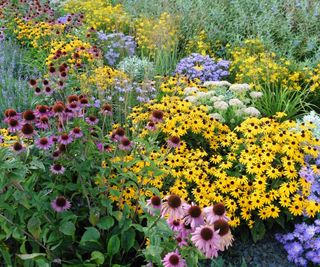
(Image credit: Getty Images/Schwirl52)
What perennials should not be cut back in the fall?
Some perennials are best cut back in fall to keep them healthy, as the plant material can overwinter diseases and pests that may come back with a vengeance in spring. Then there are those gardeners who prefer a tidy backyard and include cutting back all perennials on their fall gardening checklist. However, before heading out to prune your perennials this month, consider the merits of leaving some in place.
1. Black-eyed Susan
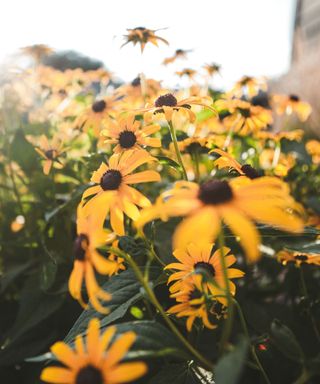
(Image credit: Annie Otzen/Getty Images)
Black-eyed Susans, also known as rudbeckias, get their name thanks to their prominent center cones. These dark cones are flanked by bright petals during the long flowering season from summer to fall, commonly yellow though there are red, gold, and orange varieties if you are looking for different varieties of black-eyed Susans to grow.
Come late fall and winter, the dried flowerheads are valuable food resources for a range of birds, including American goldfinches, cardinals, and sparrows. While the flowers will fade on black-eyed Susans, that dark central cone will remain and be a beacon of nutritious seeds for the birds.
As well as being good for wildlife, if you opt to cut back black-eyed Susans in the spring you also benefit from the fact the dark cones look particularly attractive when dusted with frost during the winter.
2. Coneflowers
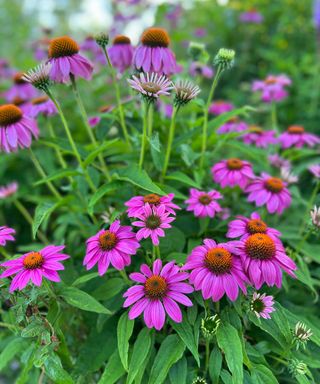
(Image credit: bgwalker / iStock / Getty Images Plus / Getty Images)
Coneflowers, or echinacea, are similar to black-eyed Susans in that they have a central cone surrounded by bright petals. This form makes them popular plants for pollinators and birds, while gardeners looking to add pops of color and attract wildlife to their backyard can choose from a wide range of coneflower varieties.
Coneflowers can look architectural during winter, with varieties ranging between two and five feet in height, and the dried seed heads also dazzle when touched by frost. The seed heads are a great food source for birds, including cardinals, bluejays, goldfinches, and other wildlife during winter.
Opting to cut back coneflowers in spring also means the stems protect the plant’s crown from extreme winter cold. Mulching around the plant can help winterize coneflowers and insulate the roots from the worst of the winter weather.
3. Coral Bells
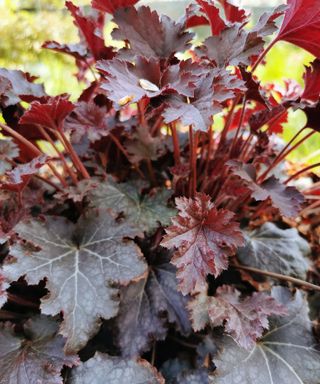
(Image credit: Shutterstock)
Coral bells, or heuchera, come in a kaleidoscope of vivid leaf colors among hundreds of different heuchera varieties to choose from. Coral bells are evergreen perennial plants in warmer climates to provide color and interest year-round. Perfect ground cover plants, especially for shadier spots, heuchera is simple to grow and care for.
If you live in an area where your coral bells provide color 12 months a year, cutting it back in the fall robs you of that winter interest. Even if your plant dies back for winter, the old leaves protect the delicate crown from winter frosts. Cutting back coral bells in the fall risks causing huge damage to the plant. Leave any healthy foliage untouched, safe in the knowledge it is helping the plant come back stronger next spring.
4. Globe thistle
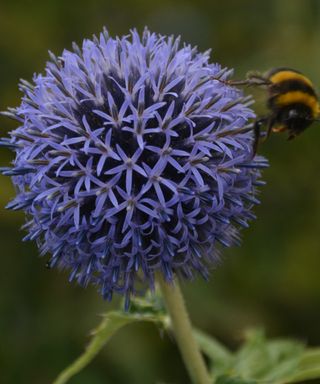
(Image credit: Future/Ruth Hayes)
Globe thistles also go by their botanical name echinops and the perennial plants are striking additions to backyard ideas. They produce large spherical blooms on top of tall stems covered in spiny foliage, making them standout additions to any flower beds or borders. Best known for blue flowers, different varieties have purple or white blooms and globe thistles are deer-resistant plants and drought-tolerant perennials.
Globe thistles are great plants for bees and butterflies during the summer and early fall. Their benefits for wildlife continue into winter as their dried seed heads provide valuable food for birds. The upright plants and dried seed heads also provide structure and aesthetic appeal in a winter garden – it all contributes to why you should not cut them back in the fall. However, whenever you cut back globe thistles wear gloves to protect against the spiny leaves and stems.
5. Milkweed
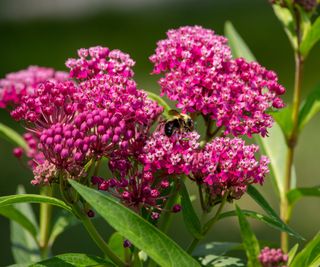
(Image credit: Getty Images / Cynthia Shirk)
Milkweed is a valuable native plant for pollinators throughout the year. It is in particular a very important food source for Monarch butterflies and the only host plant for the insects to lay eggs on and for the young caterpillars to feed.
As well as the Monarch butterfly, milkweed is excellent at attracting hummingbirds, bees, and other butterflies. As the plant’s population has dropped in the last 20 years, growing milkweed in a backyard is a fantastic way to support a host of beneficial insects and pollinators.
Come fall, those pollinators and insects can take shelter in the plant’s hollow stems if they are left standing in the garden.
6. Red Hot Poker
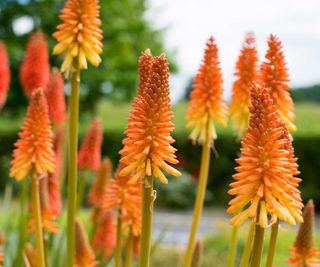
(Image credit: Kerrick / iStock / Getty Images Plus / Getty Images)
Kniphofia, more commonly known as red hot poker, are impressive plants thanks to their glowing flowering stems that come in bright shades of red, oranges, and yellow, and can reach anywhere up to four feet.
Suitable for US hardiness zone five to US hardiness zone nine, red hot pokers love warmth and are great for drought-tolerant planting ideas. While they love heat, they do not relish cold and that dictates when to prune red hot pokers. It is best to leave the plant’s foliage in place until spring, as it protects the delicate crown of the plant during the winter.
7. Sedum
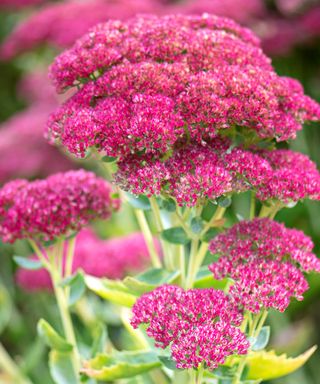
(Image credit: Getty Images/Jacky Parker Photography)
Sedum is a broad genus of plants ranging from tall plants for borders to low-growing ones ideally suited to ground cover. They are very hardy plants suited for US hardiness zone three and above and it is beneficial for nature not to cut back sedums for winter.
The dried flower heads provide shelter and food to lots of wildlife, including many native birds. Sedums are one of many perennials on this list that are great for feeding birds in winter. They are another plant that adds structure and texture to a winter garden too, especially the taller border sedums.
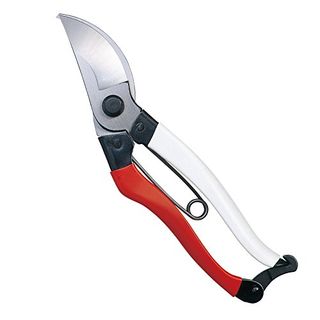
A pair of Japanese pruning shears with a high-grade steel blade and handles coated in vinyl for a non-slip grip

A pair of premium pruning shears constructed of hardened steel blades and forged aluminum handles
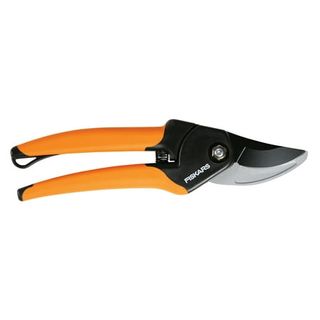
A pair of pruning shears with a low-friction coating to resist rust and help the blade glide through wood
FAQs
Should phlox be cut back in the fall?
If you know how to grow phlox, you may have experienced powdery mildew as the plants are highly susceptible. This risk increases in wet and cold weather, so cut back phlox in the fall to prevent infections as the spores can overwinter on the plant material and strike again in spring.
Should you cut back geraniums for winter?
Geraniums, or pelargoniums, are not cold hardy plants and should be moved indoors to overwinter geraniums and keep them healthy. Pruning geraniums for winter when they come indoors removes dead or diseased growth and keeps a compact shape.
If you are growing ornamental grasses in your flower beds, they are also best left unpruned this month. They add color, structure, and interest in a fall and winter garden and the best time to cut back ornamental grasses comes in spring.
Preparing Your Perennials for Winter: 7 Plants Not to Cut Back in November
As fall envelops the garden, many a gardener’s thoughts turn to preparing for winter and cutting back perennials that may now seem far past their summer heyday. The flowering display may seem long gone as the first frosts nip at the foliage, but don’t rush out too quickly to cut back all those perennials.
Cutting back in November will benefit some perennial plants, though not all require such treatment in fall. A great selection of perennials can delight in a winter garden and provide valuable food and shelter to birds and other pollinators as part of wildlife garden ideas. Some perennials also need the protection of old foliage against the winter frosts.
To help you identify which plants are best left this month in your flower beds, our guide identifies seven perennials not to cut back in November and explains why you should consider leaving them until spring.

What perennials should not be cut back in the fall?
Some perennials are best cut back in fall to keep them healthy, as the plant material can overwinter diseases and pests that may come back with a vengeance in spring. Then there are those gardeners who prefer a tidy backyard and include cutting back all perennials on their fall gardening checklist. However, before heading out to prune your perennials this month, consider the merits of leaving some in place.
1. Black-eyed Susan

Black-eyed Susans, also known as rudbeckias, get their name thanks to their prominent center cones. These dark cones are flanked by bright petals during the long flowering season from summer to fall, commonly yellow though there are red, gold, and orange varieties if you are looking for different varieties of black-eyed Susans to grow.
Come late fall and winter, the dried flowerheads are valuable food resources for a range of birds, including American goldfinches, cardinals, and sparrows. While the flowers will fade on black-eyed Susans, that dark central cone will remain and be a beacon of nutritious seeds for the birds.
As well as being good for wildlife, if you opt to cut back black-eyed Susans in the spring you also benefit from the fact the dark cones look particularly attractive when dusted with frost during the winter.
2. Coneflowers

Coneflowers, or echinacea, are similar to black-eyed Susans in that they have a central cone surrounded by bright petals. This form makes them popular plants for pollinators and birds, while gardeners looking to add pops of color and attract wildlife to their backyard can choose from a wide range of coneflower varieties.
Coneflowers can look architectural during winter, with varieties ranging between two and five feet in height, and the dried seed heads also dazzle when touched by frost. The seed heads are a great food source for birds, including cardinals, bluejays, goldfinches, and other wildlife during winter.
Opting to cut back coneflowers in spring also means the stems protect the plant’s crown from extreme winter cold. Mulching around the plant can help winterize coneflowers and insulate the roots from the worst of the winter weather.
3. Coral Bells

Coral bells, or heuchera, come in a kaleidoscope of vivid leaf colors among hundreds of different heuchera varieties to choose from. Coral bells are evergreen perennial plants in warmer climates to provide color and interest year-round. Perfect ground cover plants, especially for shadier spots, heuchera is simple to grow and care for.
If you live in an area where your coral bells provide color 12 months a year, cutting it back in the fall robs you of that winter interest. Even if your plant dies back for winter, the old leaves protect the delicate crown from winter frosts. Cutting back coral bells in the fall risks causing huge damage to the plant. Leave any healthy foliage untouched, safe in the knowledge it is helping the plant come back stronger next spring.
4. Globe thistle

Globe thistles also go by their botanical name echinops and the perennial plants are striking additions to backyard ideas. They produce large spherical blooms on top of tall stems covered in spiny foliage, making them standout additions to any flower beds or borders. Best known for blue flowers, different varieties have purple or white blooms and globe thistles are deer-resistant plants and drought-tolerant perennials.
Globe thistles are great plants for bees and butterflies during the summer and early fall. Their benefits for wildlife continue into winter as their dried seed heads provide valuable food for birds. The upright plants and dried seed heads also provide structure and aesthetic appeal in a winter garden – it all contributes to why you should not cut them back in the fall. However, whenever you cut back globe thistles wear gloves to protect against the spiny leaves and stems.
5. Milkweed

Milkweed is a valuable native plant for pollinators throughout the year. It is in particular a very important food source for Monarch butterflies and the only host plant for the insects to lay eggs on and for the young caterpillars to feed.
As well as the Monarch butterfly, milkweed is excellent at attracting hummingbirds, bees, and other butterflies. As the plant’s population has dropped in the last 20 years, growing milkweed in a backyard is a fantastic way to support a host of beneficial insects and pollinators.
Come fall, those pollinators and insects can take shelter in the plant’s hollow stems if they are left standing in the garden.
6. Red Hot Poker

Kniphofia, more commonly known as red hot poker, are impressive plants thanks to their glowing flowering stems that come in bright shades of red, oranges, and yellow, and can reach anywhere up to four feet.
Suitable for US hardiness zone five to US hardiness zone nine, red hot pokers love warmth and are great for drought-tolerant planting ideas. While they love heat, they do not relish cold and that dictates when to prune red hot pokers. It is best to leave the plant’s foliage in place until spring, as it protects the delicate crown of the plant during the winter.
7. Sedum

Sedum is a broad genus of plants ranging from tall plants for borders to low-growing ones ideally suited to ground cover. They are very hardy plants suited for US hardiness zone three and above and it is beneficial for nature not to cut back sedums for winter.
The dried flower heads provide shelter and food to lots of wildlife, including many native birds. Sedums are one of many perennials on this list that are great for feeding birds in winter. They are another plant that adds structure and texture to a winter garden too, especially the taller border sedums.
FAQs
Should phlox be cut back in the fall?
If you know how to grow phlox, you may have experienced powdery mildew as the plants are highly susceptible. This risk increases in wet and cold weather, so cut back phlox in the fall to prevent infections as the spores can overwinter on the plant material and strike again in spring.
Should you cut back geraniums for winter?
Geraniums, or pelargoniums, are not cold hardy plants and should be moved indoors to overwinter geraniums and keep them healthy. Pruning geraniums for winter when they come indoors removes dead or diseased growth and keeps a compact shape.
If you are growing ornamental grasses in your flower beds, they are also best left unpruned this month. They add color, structure, and interest in a fall and winter garden and the best time to cut back ornamental grasses comes in spring.
